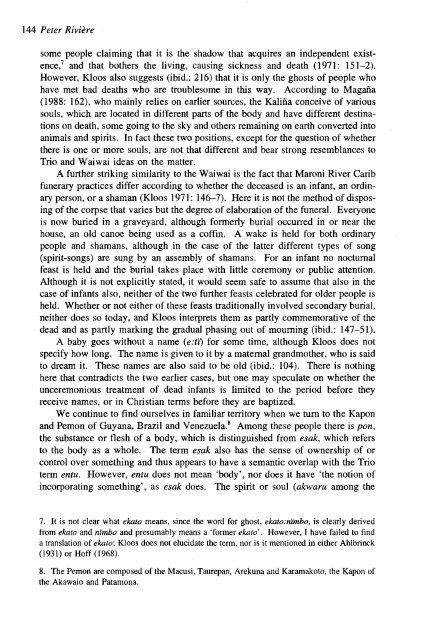godfrey lienhardt - Institute of Social and Cultural Anthropology ...
godfrey lienhardt - Institute of Social and Cultural Anthropology ...
godfrey lienhardt - Institute of Social and Cultural Anthropology ...
Create successful ePaper yourself
Turn your PDF publications into a flip-book with our unique Google optimized e-Paper software.
144 Peter Riviere<br />
some people claiming that it is the shadow that acquires an independent existence/<br />
<strong>and</strong> that bothers the living, causing sickness <strong>and</strong> death (1971: 151-2).<br />
However, Kloos also suggests (ibid.: 216) that it is only the ghosts <strong>of</strong> people who<br />
have met bad deaths who are troublesome in this way. According to Magafia<br />
(1988: 162), who mainly relies on earlier sources, the Kalifia conceive <strong>of</strong> various<br />
souls, which are located in different parts <strong>of</strong> the body <strong>and</strong> have different destinations<br />
on death, some going to the sky <strong>and</strong> others remaining on earth converted into<br />
animals <strong>and</strong> spirits. In fact these two positions, except for the question <strong>of</strong> whether<br />
there is one or more souls, are not that different <strong>and</strong> bear strong resemblances to<br />
Trio <strong>and</strong> Wai wai ideas on the matter.<br />
A further striking similarity to the Waiwai is the fact that Maroni River Carib<br />
funerary practices differ according to whether the deceased is an infant, an ordinary<br />
person, or a shaman (Kloos 1971: 146-7). Here it is not the method <strong>of</strong> disposing<br />
<strong>of</strong> the corpse that varies but the degree <strong>of</strong> elaboration <strong>of</strong> the funeral. Everyone<br />
is now buried in a graveyard, although formerly burial occurred in or near the<br />
house, an old canoe being used as a c<strong>of</strong>fin. A wake is held for both ordinary<br />
people <strong>and</strong> shamans, although in the case <strong>of</strong> the latter different types <strong>of</strong> song<br />
(spirit-songs) are sung by an assembly <strong>of</strong> shamans. For an infant no nocturnal<br />
feast is held <strong>and</strong> the burial. takes place with little ceremony or public attention.<br />
Although it is not explicitly stated, it would seem safe to assume that also in the<br />
case <strong>of</strong> infants also, neither <strong>of</strong> the two further feasts celebrated for older people is<br />
held. Whether or not either <strong>of</strong> these feasts traditionally involved secondary burial,<br />
neither does so today, <strong>and</strong> Kloos interprets them as partly commemorative <strong>of</strong> the<br />
dead <strong>and</strong> as partly marking the gradual phasing out <strong>of</strong> mourning (ibid.: 147-51).<br />
A baby goes without a name (e:ti) for some time, although Kloos does not<br />
specify how long. The name is given to it by a maternal gr<strong>and</strong>mother, who is said<br />
to dream it. These names are also said to be old (ibid.: 104). There is nothing<br />
here that contradicts the two earlier cases, but one may speculate on whether the<br />
unceremonious treatment <strong>of</strong> dead infants is limited to the period before they<br />
receive names, or in Christian terms before they are baptized.<br />
We continue to find ourselves in familiar territory when we turn to the Kapon<br />
<strong>and</strong> Pemon <strong>of</strong> Guyana, Brazil <strong>and</strong> Venezuela. 8 Among these people there is pan,<br />
the substance or flesh <strong>of</strong> a body, which is distinguished from esak, which refers<br />
to the body as a whole. The term esak also has the sense <strong>of</strong> ownership <strong>of</strong> or<br />
control over something <strong>and</strong> thus appears to have a semantic overlap with the Trio<br />
term entu. However, entu does not mean 'body', nor does it have 'the notion <strong>of</strong><br />
incorporating something', as esak does. The spirit or soul (akwaru among the<br />
7. It is not clear what ekato means, since the word for ghost, ekato:nimbo, is clearly derived<br />
from ekato <strong>and</strong> nimbo <strong>and</strong> presumably means a 'former ekato'. However, I have failed to find<br />
a translation <strong>of</strong> ekato; Kloos does not elucidate the term, nor is it mentioned in either Ahlbrinck<br />
(1931) or H<strong>of</strong>f (1968).<br />
8. The Pemon are composed <strong>of</strong> the Macusi, Taurepan, Arekuna <strong>and</strong> Karamakoto, the Kapon <strong>of</strong><br />
the Akawaio <strong>and</strong> Patamona.
















